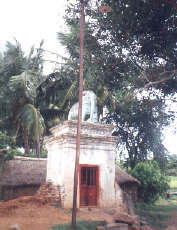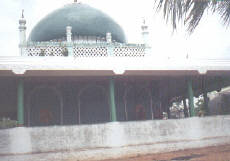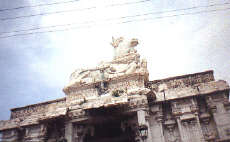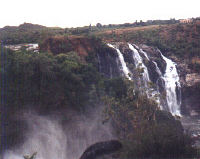The Drive to Somewhere
Shivasamudra, Mysore, India


The elephant statue on the road.
![]()
![]()
It seems to be a case straight out of Ripley’s Believe It or Not. Yes, the state Karnataka where I reside, a sandalwood smuggler and his gang of merry men have held the state to ransom. Every now and then, there is a kidnapping incident. Earlier it was of a famous film star and now of a former chief minister. Needless to say, the forest areas in Karnataka or adjoining state of Tamil Nadu, where he hides with his hostage, suddenly becomes out-of-bounds for us honest trekkers.
And all this certainly dented my holiday plans. So, to put a really long extended weekend to some fruitful use, I decided nonetheless to hire a car and go out of the city outskirts, to somewhere near Mysore, and managed to convince my friend “PP” to join me on a trip to ‘somewhere’.
Shivasamudra, where lies India’s first hydropower station, set up in 1902 by the Mysore Maharaja seemed a safe bet. (Author’s note: since our trip this place is not at all safe. Tamil Nadu, a bordering state, is demanding release of water to the detriment of the farmers in Karnataka, and there have been wide-scale protests, including suicide attempts by farmers.)
PP and I had made sure that the driver was fluent in Tamil, which is what Veerapan speaks (some consolation this!). And the River Cauvery has fascinated me. With the monsoon in full swing, I knew this river would be in its full fury.
The drive down to Shivasamdura was uneventful. We did pass Channapatna, the town famous for its wood handicrafts, which includes brightly colored rocking chairs. But, there is nothing more to add, other than that I realized PP hates shopping almost as much as I do.
In four hours we traversed through a largely agricultural area, sugarcane thickets, bajra (grain) fields, bamboo forests and vast areas of land that had just been sown and to us seemed absolutely barren. A national highway is being broadened, and tons of trees were being mercilessly chopped down along both sides of the road. The wild lantana flowered in various hues of pink, purple and orange – in colors I had not seen before; they clung bravely to the sides of the ever-widening hilly road.
Like any computer geek, I had surfed the Internet, but all that I had found on the website of the tourism ministry of Karnataka was that the River Cauvery at Shivasamudra Falls (in Mandya district) has twin jumps, Gaganachukki and Bharachukki, one km away from each other.


The green domed shrine.
![]()
![]()
Well, sometimes it is best that even in this cyber era, the world is capable of throwing up some hidden surprises.
We came across the dam and the government circuit-house. Manned by sentry, a board proclaimed that photography was strictly prohibited. Seeing the woeful look on my face, a smiling guard let me click a photograph without embarking from the car; of course the shot taken is not very good, but then something is better than nothing. Waving away we drove off farther up the road.
A left turn marked a detour to the famous waterfalls. But I was intrigued by a group of people, dressed in their best and trudging farther ahead. We decided to follow the locals; perhaps we would come across a weekly market or something.
It turned out to be some sort of holy lane. I think India is a very religious country. In one corner was a massive painting on a wall of Lord Hanuman, the monkey god who saved Sita, wife of Lord Ram, from the clutches of the demon Ravana. Garishly painted in bright oil colours, the villagers used it not only as a meeting place but also for hanging up clothes to dry. Equally brightly coloured saris and clothes were hung on the adjoining fence. Was this it? Seemed unlikely.
So we moved on farther and came to a check naka, a place where octroi is collected. It is these officials who informed us that farther on was another temple, the Someshwara Swamy Temple and also a shrine of saint Mardane Gaib.
We had time to kill so we moved on. And yes, there was a temple in pristine white (why was it painted though? the old stones would have had a much better effect). Alas, the front doors were locked. PP and I banged on the doors, much to the amusement of our driver, who we found later, could only speak in Tamil and not a word of English. Well, well, our trip was not turning out to be so great.


The cow atop the temple.
![]()
![]()
Since I had just acquired a brand new camera, I decided to put it to full use. Not only did I photograph the scared cow atop the front gate of the temple, but also the notice stating its history. A few other ancient pillars, on which was perched either Nandi, the sacred bull, or an elephant, were also scattered here and there.
Moving further ahead, we came across a spectacular sight. The rushing Cauvery, it gushed against the rocks and made a real pretty picture. Somehow the sound of rushing water seems so soothing. I was all set to sit on the bank of the river, when PP noticed that there were lots of shops out here, and all were open yet empty.
Fish was strung at the entrance of these shops, large frying pans were kept ready, dough for the naan (bread) was marinating. Yet, everything was empty. Had we just missed an earthquake or something?
“Let us move,” said PP, picking me up. And then we heard the chant of prayers. Oh, it was Friday, and there was a mosque right behind us. Perhaps the entire populations of this area were devout Muslims, who had gone for namaaz (prayers).
Our driver had disappeared. Behind the mosque was the shrine that the people at the Octroi checkpost had spoken of. A few ladies were sitting there, and we made our way out there. We checked first, but people of any religion, caste or creed were welcome to sit beneath the open veranda of the shrine.
Our attire of dirty jeans and T-shirts and our city-bred looks did evoke a lot of curiosity. Kids crowded around us; the ladies asked questions. Most of them were here to offer the Friday prayers.
A large pot smelled of something delicious. Of course, we had to taste it, but the food would be served to all only after the Friday namaaz was over. We decided to hang around and explore a bit more.


The waterfall behind the shrine.
![]()
![]()
Then, we saw another sight: a waterfall. Gushing down into the river, it was just so awesome, the afternoon sunlight led to the reflection of light from the millions of droplets creating a fairyland. Hmmmm, I could sit across this sight for eternity.
But hunger pangs made us proceed back towards the shrine. And yes, we were rewarded with a plate of sweet rice (rice cooked in jaggery with nuts). Different, but yummy. The shopkeepers were back. The smell of frying fish took over the atmosphere and we too had our fill. Freshly caught fried fish dipped in masala with naan. I sure had not tasted anything like this earlier.
Unfortunately, we still don’t know much of the legend behind this shrine. We were told that there is another shrine hidden among the rocks in the river, but this we could not see because the river was in its full fury. Nor did we learn anything about the locked temple.
Well, I guess it is not always possible to learn about local legends and histories behind temples and shrines. The view of the waterfall and the wonderful lunch was satisfaction enough. The drive to somewhere was an interesting one after all.